Starting with 1903’s “The Great Train Robbery”, the western has been a staple of American, and international, cinema. The genre can range from savagely brutal, like “The Hateful Eight,” to side-splitting comedy like “Blazing Saddles.” Sure, there’s a certain level of machismo present, and the swagger on screen can quickly devolve into my friends and I pointing at the television, grunting in approval, drinking some pretentious craft beer and munching on Archer Farms potato chips. Hey, spend money where it matters: the beer. If the beer is good, the snacks can suck, but I digress.
There is something about the genre that feels intrinsically American. Something about the last time there was a frontier to conquer, a right to wrong, a damsel to save that just makes sense in the context of a western. TV has a hit or miss record with cowboys. If you haven’t seen the shows, “Copper” and “Firefly” are not technically westerns, but they capture the spirit of a western perfectly. Hollywood has gone through cycles with the genre as well. I’m going to ignore the bad ones and focus on my faves.
Enough of the deconstructionist diatribe. There are plenty of great films with horses, cowboys, and plenty of gunfights. Here’s a list of a bunch of them that I love. Enjoy.
Unforgiven (1992)
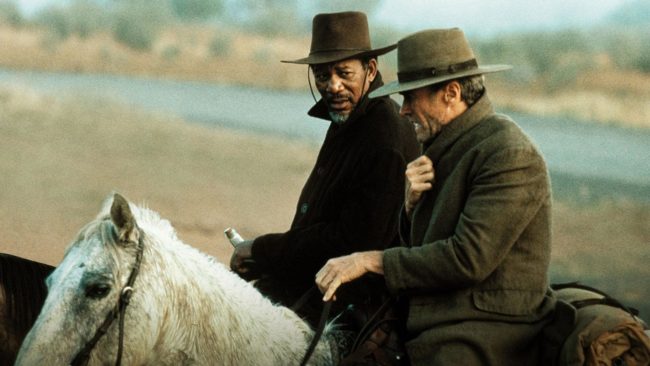
Speaking of deconstruction, Clint Eastwood turned the western genre on its head with this moody, dark piece. Eastwood directed and starred as William Munny, the morally ambiguous, former merciless killer redeemed by love. His wife died, but Munny is still the devoted family man, farming, raising his two children, and mourning his lost love.
Munny’s relative peace is broken when his old life creeps back in. A prostitute was slashed on the face by a drunk cowboy. Munny enlists his old friend Ned Logan (Morgan Freeman) and they head off to Wyoming to meter out revenge/justice in a town run by Sheriff Little Bill (Gene Hackman, at his conniving best). Old Munny is nowhere to be found as he enters Little Bill’s town, and he takes a beating in the local bar. But his switch is flipped when Logan meets a cruel fate and Munny turns back into the whirling dervish of heavily-armed karma. There is no remorse in his voice, no fear in his eyes, just the barely restrained warning he issues, followed by a hail of gunfire and a whole lot blood and dead guys.
“Unforgiven” is a messy, muddy film with enough brooding going on for ten movies. It’s also brilliant beyond words. Think whatever you like about Eastwood’s politics and his strange discussion with a chair, but he is a capable actor and director and his film’s are always more than watchable.
The Magnificent Seven (1960)
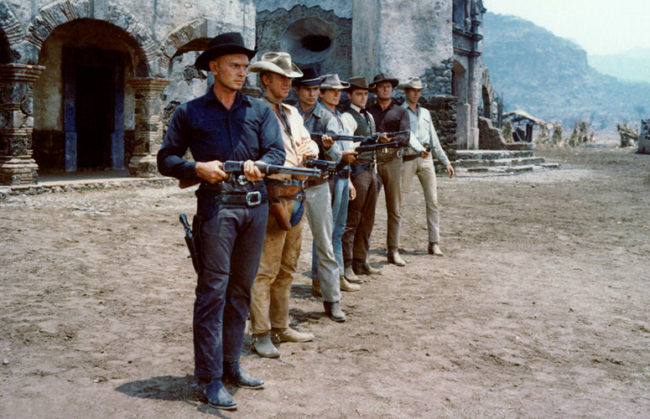
John Sturges took a classic Japanese film, re-made it for American audiences, and did not screw it up. Inspired by the classic movie “Seven Samurai,” “The Magnificent Seven” follows a ragtag group of seven American gunfighters who band together to defend an oppressed Mexican village. Much like the Akira Kurosawa’s “Seven Samurai,” the village in question is peopled by the innocent and the defenseless and the bad guys are just that, bad.
Yul Brynner, Eli Wallach, Steve McQueen, Charles Bronson, Robert Vaughn, Brad Dexter and James Coburn are the above named septet, each one a different brand of awesome. And a different brand of damaged goods. A screwed up bunch, defending the defenseless in a shoot-out that is going to go badly for everyone involved. Sturges knew he could make a note for note remake, so he did his best to make subtle changes and give Bronson’s Bernardo O’Reilly a great scene correcting a boy about true heroism and to always remember his father is far from a coward.
As for the useless trivia affiliated with this picture, Oscar winning composer John Williams was a member of the orchestra that recorded Elmer Bernstein’s score; he played the piano. Also, after seeing Sturges film, Kurosawa sent a ceremonial sword as congratulations.
The Good, the Bad and the Ugly (1966)
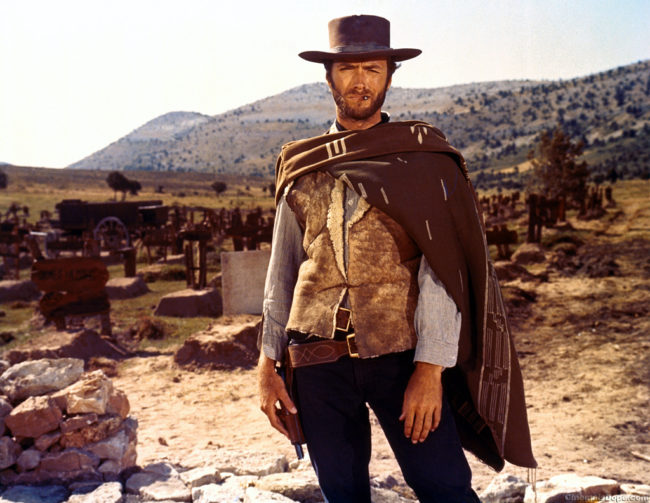
“The Good, the Bad and the Ugly” is the last in Sergio Leone’s classic trilogy of “spaghetti westerns.” After “A Fistful of Dollars” and “For A Few Dollars More” it seemed like Leone had nowhere else to go. Wrong. The man was just getting started.
Cinema will always be emblazoned by the iconic images of Clint Eastwood chomping on a cigar so filthy and stinking you could smell it in the theater. There is no dialog for the first 10-1/2 minutes of the film. There is, however, cinematography that pulls in close enough to see the beads of sweat clinging to the razor stubble on the faces of dusty Civil War vets caught in a triple cross. There’s Confederate gold is out there in the grave of a dead soldier buried somewhere in Sad Hill Cemetery, waiting to be found and these three are going to find it, then kill the other two.
The iconic sound of Ennio Morricone’s soundtrack rings in your ears for days after. Eli Wallach and Lee Van Cleef command the screen as much as Eastwood. This is not just a movie, it is dude Nirvana.
Blazing Saddles (1974)
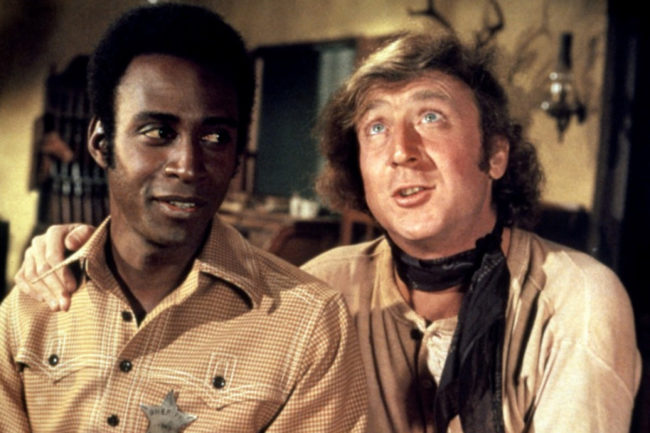
Mel Brooks made several laugh out loud funny films. “Young Frankenstein” brings me to tears because I’ve laughed so hard. As funny as it is seeing Gene Wilder as the hesitant mad scientist is seeing him in “Blazing Saddles” as the Waco Kid. In fact, it is hard to think of anything about this movie that is not riotously funny. The African-American sheriff, appointed to fail, a town full of people named Johnson, Slim Pickens being Slim Pickens, and Harvey Corman as Headley Lamar… it all adds up to great, if massively non-politically correct, viewing.
I first saw “Blazing Saddles” at the Aero Drive-In in El Cajon with my parents and my brother Dominic. I can still hear my Dad laughing when the Native Americans began speaking Yiddish. I howled at the orchestra in the desert and the toll bridge in the middle of nowhere. If you haven’t seen it, you need to. You’d do it for Randolph Scott.
Butch Cassidy and the Sundance Kid (1969)
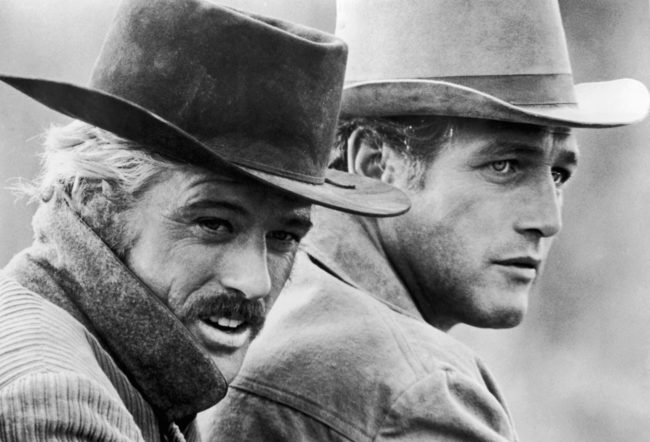
This classic is loosely based on the real lives of western outlaws Robert LeRoy Parker (aka Butch Cassidy) and Harry Longabaugh (aka the Sundance Kid). “Butch Cassidy and the Sundance Kid” is a movie about two buddies trying to make it in a changing world. It offers the awesome on-screen chemistry of Robert Redford and Paul Newman. The pair have such a natural on-screen presence and likability, you almost forget they’re a pair of criminals on the run.
Worthless trivia alert: On the first day of shooting, involving the train robbery scenes, co-star Katharine Ross came to the set to watch the filming. The Director of Photography was one camera operator short, so he enlisted the help of Ross. He showed her how to operate it, and how to move it to get her shot. Director George Roy Hill was furious, but he initially said nothing. At the end of the day, however, he banned her from the set except when she was working.
High Noon (1952)
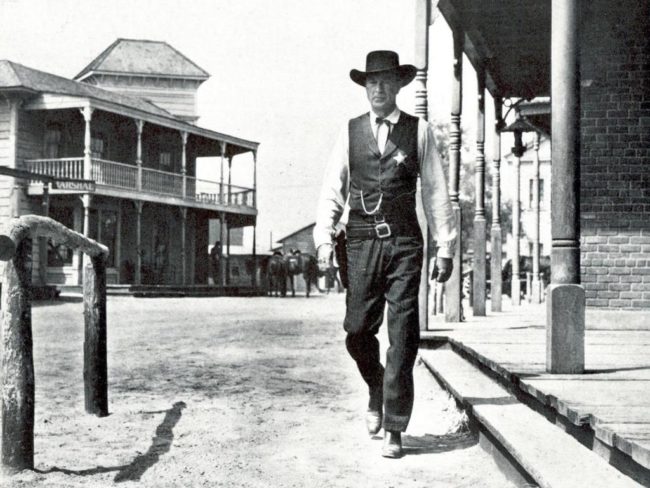
This is a film about being torn in too many directions at once. Being torn between duty and love and standing up for what you believe in, even if it means you are standing alone. Gary Cooper plays Will Kane, a town marshal from New Mexico, who settles down with his Quaker wife (played by Grace Kelly, to this day she is still one of the most gorgeous women to ever cross the silver screen).
Cooper’s version of Kane is note-perfect. His grand plan for a peaceful life are put in jeopardy when interrupted when he gets news that a former gunslinger Frank Miller (played menacingly by Ian MacDonald) with a vendetta to settle is coming in on the noon train. His pacifist wife pleads with him to leave town, but the stoic Kane knows he has to stay to defend his honor, his town and pretty much everything else he believes in.
Kane knows nobody has his back when the battle begins. The town and his less-than loyal deputy run away from Kane and the tension is palpable. Director Fred Zinnemann wins points for the look and feel of a hopeless situation where a guy stands on a dusty street, alone with his honor. Oh, and a brutal killer bent on vengeance.
The Wild Bunch (1969)
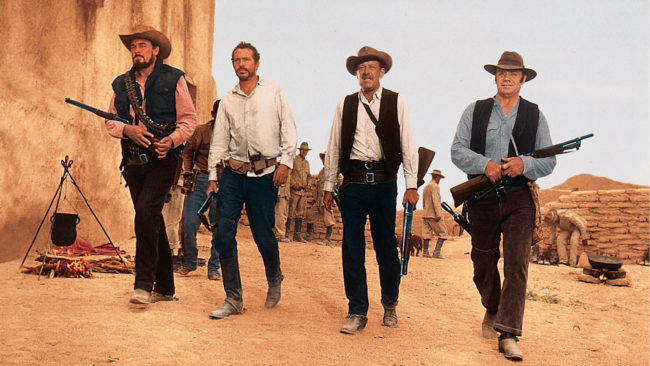
Sam Peckinpah directed this nihilistic, violent and bleak picture of the wild west fading to a close. It is 1913, and the west is not so wild anymore. The sheriff with a badge is being replaced by a more uniform code of justice, backed up by laws. The skills needed to survive the past 20 years have become obsolete or unneeded.
With time no longer on their side, an aging group of outlaws decide to go out in a hail of gunfire and gore. “The Wild Bunch” was and is a controversial film. Some historians say the film then symbolized the end of the classic American Western. All I know is Peckinpah makes sure the camera does not look away when the violence rears its head. He doesn’t flinch from the gory and the disgusting. That ought to be enough to sell it to the uninitiated.
If that’s not enough, the opening gunfight runs five minutes (edited down from the original 21 minutes), and Peckinpah was a taskmaster. He would drive his crew so hard that it sometimes caused friction and confrontations. William Holden threatened to walk off the set if Peckinpah continued to verbally abuse the crew in his presence. Driven to violence of camera, Robert Ryan threatened to punch the director after he made Ryan spend ten days in costume and makeup without filming any scenes or allowing him a few days off to campaign for Sen. Robert Kennedy. Making no secret of how far he had been pushed, Ernest Borgnine apparently told anyone who would listen that he was going to “beat the shit out” of Peckinpah if the director didn’t give him some time away from the throat-clogging dust that was affecting the actor’s breathing on location.
Shane (1953)
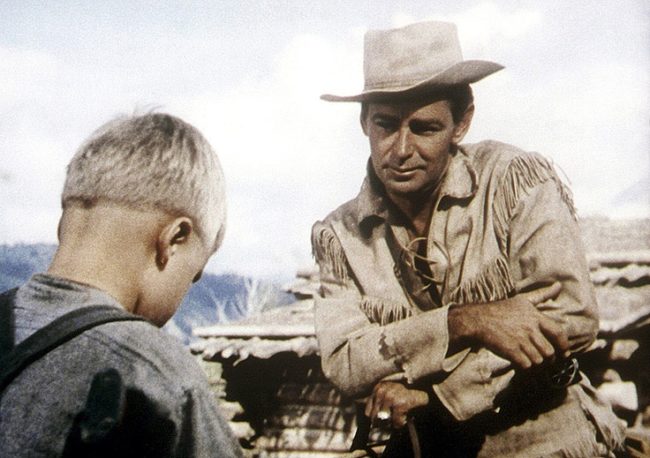
“A gun is a tool, Marian; no better or no worse than any other tool: an axe, a shovel or anything. A gun is as good or as bad as the man using it. Remember that.” Words of wisdom from a quiet gunslinger, trying to outrun his past. Shane (Alan Ladd) comes across and befriends a pioneer family that is attempting to settle out west. He attempts to settle down and become a hired hand to the family. Certainly, something has to upset this happy little story. Enter the ranchers.
Evil ranchers, lead by the surly Jack Palance, want to drive cattle through the homesteaders’ property are attempting to push them out. Shane tries to stay above the fray, but keeps getting dragged into the deep end of the muck. Finally, Shane is compelled to strap his six shooter back on to protect his adoptive family. As you can probably guess, Shane and the ranchers sit down over herbal tea to discuss their positions in a fair, open manner. Well, sort of. It’s more of guys in a saloon, getting shot and Ladd is all kinds of low-key cool.
From the opening shot of a bus in the background (one of the biggest on camera mistakes ever), and the obvious fact that Shane’s gun goes off well before it is aimed at the bad dude, there are well-documented mistakes that made it into the film. George Stevens directed with his typical steadiness. Nothing fancy or flashy, just a solid job with a decent script and acting that gets the job done. If there was a film that carries a lunchpail to work, it’s “Shane.”
Silverado (1985)
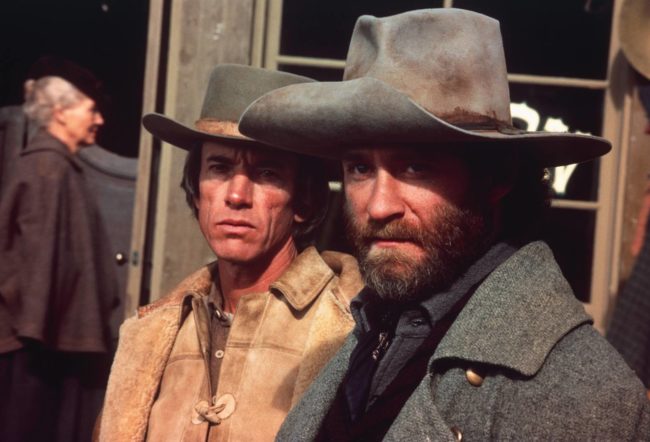
“Silverado” takes all of the cliches about western films, shakes ‘em up and pours out a great movie on the screen. Here are a bunch of actors at the top of their respective games. Kevin Kline, Scott Glenn, Kevin Costner, Danny Glover, Patricia Arquette, Brian Dennehy, Jeff Fahey, Jeff Goldblum, John Cleese and people I’m sure I’m forgetting populate Lawrence Kasdan’s film.
It’s a story about settling the west, friendship, loyalty, wide open-range cinematography, an English sheriff (Cleese, in typically brilliant form) keeping law and order in a dusty town. Kline is charming and travels a long way from ending up robbed and beaten and wandering in a pair of red longjohns to the film’s climax. This is Kasdan shaking off the talky “our generation rocked, but our lives suck” enui of “The Big Chill” and just people have fun and root for a bunch of good guys.
Destry Rides Again (1939)
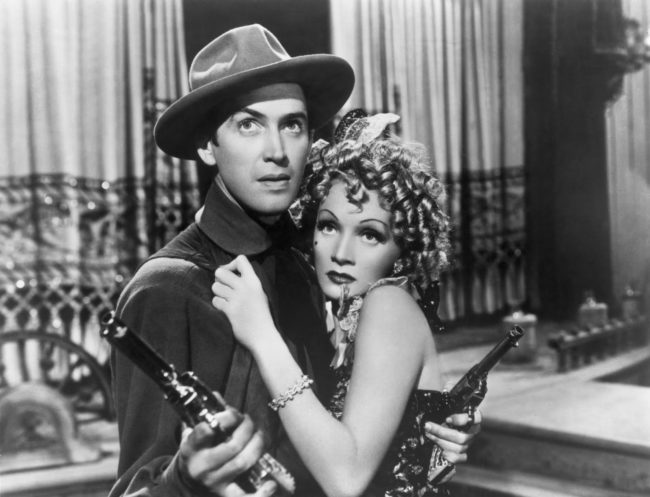
Jimmy Stewart’s first western was far and away his best. Taking a hard right turn from his romantic comedies and Frank Capra films he had been making, Stewart is brilliant. Directed George Marshall, and working with a cast that included Marlene Dietrich, Mischa Auer, Brian Donlevy, and Una Merkel as the residents of a lawless town, Stewart is Destry, the guy tasked with cleaning up the ungovernable whistle-stop. The sheriff of Bottleneck is killed after asking too many questions about a poker game, leaving Stewart’s Destry in charge.
Destry is the guy who wears the white hat, the mellow guy who drinks milk and does not carry a gun. He is no coward, though. And when the local thugs threaten his friends, things get real in a hurry.
There is also a 1932 version starring Tom Mix, who does carry a gun and is slightly tougher than Stewart. Mix had more riding skill and used his fists, but Stewart’s version holds up better. Both are worthy films, the version with Audie Murphy, titled simply “Destry,” is not.
